I begin flight planning for the trip from Phoenix, AZ to Malaga, WA with my new helicopter.
I haven’t been blogging much about flying lately, but that’s because I haven’t been doing any lately. It took me about a month to find a good replacement for my old helicopter and, truth be told, I haven’t even gone to see it in person so I don’t have any good stories or photos to share. I’m thinking of discussing the purchase in a separate blog post and if life doesn’t stop hurling distractions at me, I might just get that done. But it’ll be a complete piece — from the start of the search to the pickup of the replacement helicopter — and since that process isn’t complete yet, I can’t very well write about it.
So instead I’ll give you an idea of what’s going through my mind this weekend and week as I plan to fly the replacement helicopter home from the Phoenix area.
Planning a Flight in the American West
The one thing that city folks — and people from areas areas that are normally or densely populated — don’t get is that out west there can be very long distances between points. And since there aren’t as many people here outside the big cities, there can be a whole lot of nothing on a long cross-country flight. Or even on a relatively short one. Heck, when I was first building time in my R22, I once flew solo in a straight line 85 miles east to west just north of the Grand Canyon’s airspace and didn’t cross over a single paved road for the entire distance. Can you do that in New York?
I used to fly between Arizona and Central Washington twice a year. From 2008 to 2013, I lived in Wickenburg, Arizona and spent 7 to 16 weeks every summer in the Wenatchee area of Washington for cherry drying. In May, I’d pack up the helicopter and fly north and in July or August, I’d pack it up again and fly south. I often had a pilot interested in building time in an R44 at the stick to help cover flying costs; once (I think) it was my future wasband, who got the flight time for free on a flight that included a good part of the Oregon coast.
There are basically four good routes — five if you count the California/Oregon coastal route — to get from the Phoenix area of Arizona to Central Washington State. Those routes are determined primarily by terrain, fuel availability, and airspace restrictions.
The Shortest Route
By far, the shortest route is through the middle of Nevada. Going north from Wickenburg (E25), it’s Mesquite, NV (67L), Elko, NV (EKO), Burns, OR (BNO), to Wenatchee, WA (EAT). Note that those legs are pretty long — 2-1/2 or more hours each. But it’s only 891 miles total and I’ve done the whole flight in a single day twice with another pilot on board.

Here’s Foreflight with the shortest route plotted in. I added a waypoint to route me around the Grand Canyon’s airspace, which I can’t fly through. There’s a whole lot of nothing on this route.
Pros:
- Short route; it can be done in less than 10 hours without headwinds.
- The shortest route is also the cheapest route.
- Only three fuel stops also speeds up the trip; stopping for fuel takes at least 30 minutes.
- Between Elko and Burns, there are many herds of wild horses.
Cons:
- Not many options for fuel if headwinds slow you down. Rerouting along the way could make the trip a lot longer.
- Flight crosses miles of empty desert with absolutely no sign of civilization. For example, there’s a stretch between Elko and Burns where there are no roads, buildings, or even fence lines for more than 90 minutes of flight time. So if you need to land because of a problem, you’re pretty much screwed.
The Salt Lake City Route
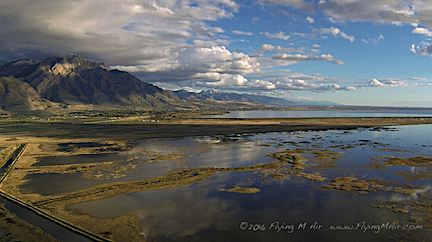
My GoPro nosecam captured this amazing image of Salt Lake on my last flight southbound through the area in October 2016.
When I flew the late, great Zero-Mike-Lima south to get its overhaul back in 2016, I took what I call the Salt Lake City route. This route follows roads pretty much all the way. Zero-Mike-Lima’s engine was nearly 12 years old and an oil change had uncovered more than the normal amount of metal fragments in the filter. If the engine was going to give me trouble, I wanted to be able to land somewhere close to where I could get help and that meant near a road. An example of this route goes from Wickenburg (E25) to Page, AZ (PGA), Salt Lake City (Skypark), UT (BTF), Burley, ID (BUR), Pendleton, OR (PDT), and Wenatchee (EAT). This comes out to a minimum of 985 miles.
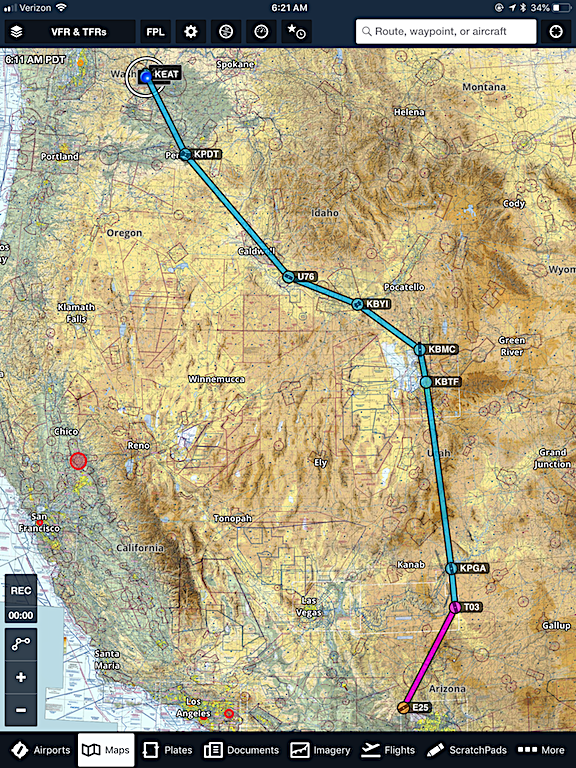
This is what I call the Salt Lake City Route, IFR edition. I’ve added waypoints beyond the fuel stops listed here, to guide me around the Grand Canyon’s airspace and keep me over roads for most of the way.
Pros:
- I can be an IFR (I Follow Roads) pilot. There are very few stretches along this route that can be considered remote.
- There are corner-cutting opportunities to save time and fuel. For example, if I don’t mind flying over Salt Lake, I can go direct from Salt Lake City to Burley. (I really don’t like flying over water so I’ve only done that once.)
- There are many potential fuel stops along the way. And many options for short detours to get to them.
- The first 2 hours of this flight takes me over my old stomping grounds in northeastern Arizona, including the Navajo Reservation and Lake Powell.
- My friend Megg lives in Salt Lake City and has, more than once, provided overnight accommodations.
Cons:
- It’s not the shortest route. I don’t think it can be done safely by one pilot in a day.
- It crosses over a lot of high elevation terrain. In April, that means there’s a real possibility of snow or icing conditions that I can’t fly in. Getting grounded because of weather wastes time and gets expensive.
The Western Nevada Route
Another way to go that successfully avoids the restricted airspace in Nevada is up the east side of the Sierra Nevada Mountains and up into Oregon. In looking at this route, I realized that I’d never done the whole thing. Once I traced the Tonopah (southeast of Hawthorne) to Wickenburg part of this route with my wasband on board when we had to abandon the coastal route, stopped for the night at a friend’s house in Georgetown, CA, and came over Echo Pass near Lake Tahoe. We might have cut through Death Valley along the way. The route I’m looking at now is at least 942 miles: Wickenburg (E25), Jean, NV (0L7), Hawthorne, NV (HTH), Lakeview, OR (LKV), Yakima, WA (YKM), and Wenatchee (EAT).
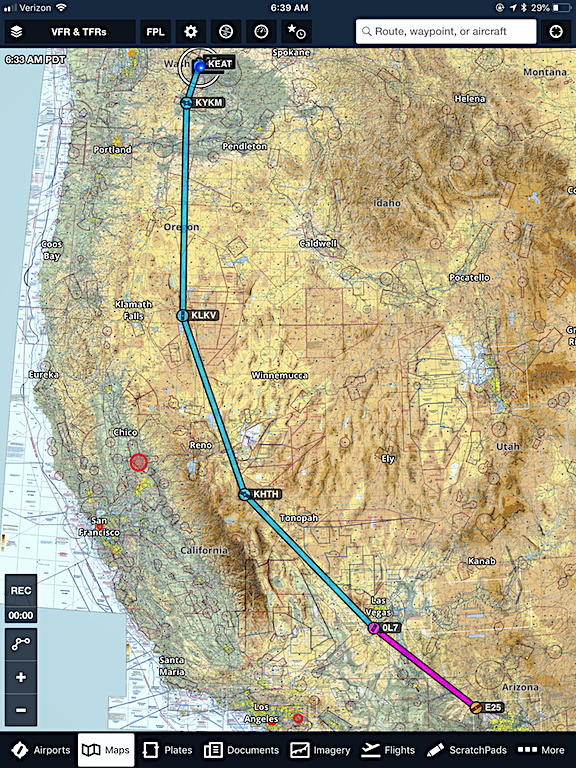
The western Nevada route is one I’ve never done before, but it looks like it might work out.
Pros:
- Relatively short route.
- Not completely familiar so I’d get to see new sights.
- A stop at Hawthorne would mean getting to see Betty, the unofficial airport greeter there.
Cons:
The Central California Route
The longest two routes take me through California. The shorter version goes up the Central Valley of California. I basically head west through the Arizona and California deserts, then pop over the foothills of the Sierra Nevada Mountains at Tehachapi and fly up the Central Valley. Then I continue North through Oregon on the East side of the Cascade Mountains. A flight plan might be Wickenburg (E25), Apple Valley, CA (APV), Porterville, CA (PTV), Woodland, CA (O41), Redding, CA (RDD), The Dalles, WA (DLS), and Wenatchee (EAT). That’s a minimum of 1100 miles.

The Central California route is long but very familiar. The stops shown here are just an example; there are plenty of options for fuel and overnight stay in the Central Valley.
Pros:
- I know this route really well. I can’t tell you (without looking in my log book) how many times I’ve flown either the entire thing or parts of it.
- There are lots of places in California’s Central Valley for fuel and overnight stops.
- More than half the route is through heavily populated areas. Plenty of places to get help if needed.
- There is very little high terrain so winter weather is not likely to be an issue.
- Weather is nearly always perfect — although it could be windy — in the desert areas.
- I can stop along the way to pick up the cockpit cover for my old helicopter, which is somewhere in the Sacramento area of California.
Cons:
- The route is long. Enough said.
- There’s a chance that you won’t be able to cross into the Central Valley at Tehachapi because of low clouds on the Central Valley side. The wind seems to funnel the weather south and when the clouds hit the mountains there, they just stop and accumulate. I’ve had this happen to me twice. The options are to wait it out or detour farther west to Grapevine.
- Just under half the route is through sparsely populated areas.
- There are limited fuel stops in the desert areas and in Oregon.
- Did I mention that the route was long?
The Coastal Route
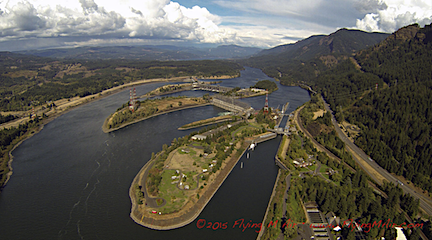
When I fly back from the coast, I usually fly along the Columbia River. Here’s a nosecam shot of the Bonneville Dam. I can’t get my hands on any of my coast photos right now.
If you’ve never flown in a small aircraft, low and slow up the coast of California and Oregon, you have no idea what you’re missing. When the weather is good, the flight is absolutely amazing. I’m talking about tiny seaside communities, waterfalls plunging off cliffs into the Pacific Ocean, and odd rock formations just off the coast with waves crashing picturesquely against them. If time and money is no object, this is the way to go. A typical route might be Wickenburg (E25), Apple Valley, CA (APV), San Luis Obispo (SBP), Half Moon Bay, CA (HAF), Eureka, CA (EKA), North Bend, OR (OTH), Tillamook, OR (TMK), The Dalles, WA (DLS), and Wenatchee (EAT). Those aren’t all fuel stops; they’re just points along the way where fuel is available. This flight is over 1300 miles long if you follow the coast as closely as possible. It’s a lot longer if you join the coast at a point south of San Luis Obispo — for example, Santa Barbara (SBA) or Long Beach (LGB).
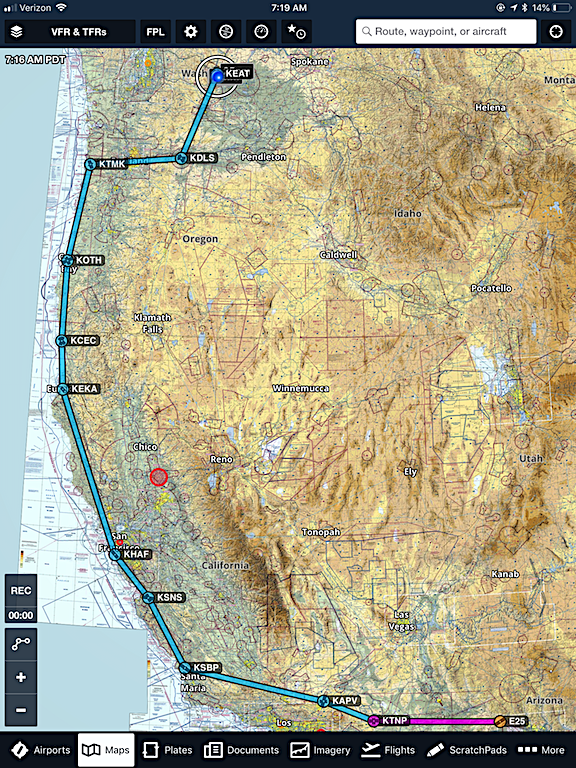
Got money to spend and time to kill and you don’t mind gambling with Mother Nature? Then do the coastal route. The extra waypoints I plotted in here are just to keep you on the coast as much as possible. You’d have to calculate and pick your fuel stops.
Pros:
- The scenery! There’s none better.
- Lots of fuel stops — if you plan properly.
- Did I mention the amazing scenery?
Cons:
- Weather. The chances of being able to stay on the coast for the entire distance from San Luis Obispo to Tillamook are about as close to zero as you can get without hitting zero. The marine layer is real and it will definitely force you inland for at least part of this route. That means you need to have an infinite number of Plan Bs. And there’s nothing worse than flying out of your way to get to the coast and then having to backtrack because it’s socked in with fog.
- Possibly flying over water. I hate flying over water.
- Some of the coastal areas are quite remote. So even if you’re flying over land, if you have a problem and need to land you might not be anywhere near help.
- You can’t stick to the coast in certain wildlife refuge areas unless you want to climb to 2000 feet. I get nosebleeds up there.
- The airspace gets a little crazy around San Francisco, especially if you have to come inland.
- And seriously: 1300 miles for a trip you can do in less than 1000 miles on at least two other routes? A bit extravagant, no?
Picking a Route
Those are pretty much the options I’m looking at. I was leaning toward the Central California route until I started looking at the Western Nevada route in more detail. It definitely has possibilities and I shouldn’t write it off just because I haven’t done it before. If it saves me 2 hours of flight time, that’s hundreds of dollars in ferry flight costs. While I don’t think I can do it in a day, it’s definitely feasible.
In the end, there are just two things that will help me make the decision: the weather forecast and whether I can stop in California to fetch that cockpit cover. And although my flight is scheduled to begin on Friday, April 13 — yeah, I know — it’s still to early to get a reliable forecast. I’ll likely decide by Wednesday or Thursday — and be prepared to change my mind.
That’s how flight planning goes.
Discover more from An Eclectic Mind
Subscribe to get the latest posts sent to your email.

That’s some great cross country common sense. Can’t wait to see your new helicopter, Maria. Good luck with it!
I can’t believe that I’ve been doing this trip for ten years and I never blogged about the planning that goes into it. I’ve always done long cross-country trips — heck, I took my R22 from Arizona to Eagle, CO once and to Placerville, CA another time — and although I always do some planning, I admit that this is the first time I took a really close look at my four (or five) options. At this point, it’ll likely be the Central California route, mostly because I don’t know the helicopter very well. Or at all, actually.
I can’t wait to see it, too!
If the coastal weather forecast is good I would be drawn to that stunning scenery (albeit longer flight time) of the last (western) option you describe.
But, in a helicopter that will be new to you, a drier and more direct route with well-spaced fuel stops, might be the more rational choice if you are doing all the flying.
Whatever your choice, have a safe and pleasant journey.
I’ve only had good luck on the coastal route ONCE — and even then it didn’t look good when I first reached the coast. That was from Mendocino, CA to Tillamook. I’ve tried it at least five times. It’s just too far out of the way on this trip.
Thanks for the good wishes. I hope to take a few photos along the way — or let my companion do it — and blog about it when I get home.
Thanks Maria. I really enjoyed the detailed information.
You’re welcome. I did a lot more planning than usual for this flight. I think it’s part of my conscious effort to avoid complacency after my crash.